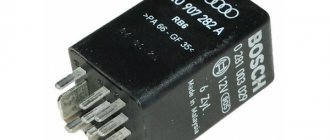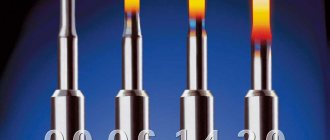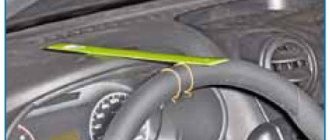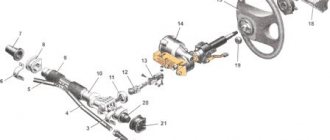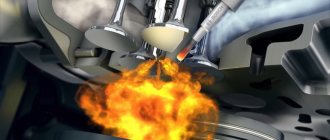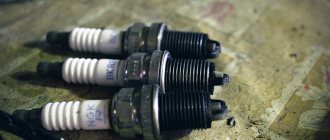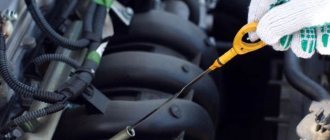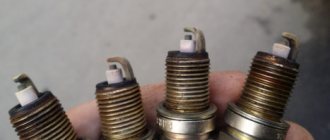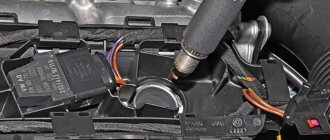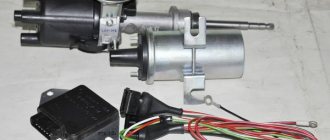Glow plugs on diesel engines are often the weak link in cold weather. Owners of such cars often have to cancel planned trips because their engine stubbornly refuses to start. In this article we will describe three simple ways to check diesel glow plugs.
Glow plugs play an important role in starting a diesel engine in cold weather. Thanks to their heating of the combustion chambers, it is possible to facilitate the ignition of fuel in the engine cylinders.
The fastest way to check glow plugs for a diesel engine is shown in detail in the video at the end of the article.
Depending on the model and age of the car, there are different principles of operation of the diesel engine heating system:
- In older cars, glow plugs usually turn on almost every time the engine is started.
- Modern cars can start successfully even without glow plugs at above-zero temperatures.
Therefore, before starting to diagnose the diesel preheating system, you need to find out at what temperature conditions the combustion chamber is heated. The switching on of the glow plugs on the instrument panel is indicated by a corresponding light bulb in the form of a spiral.
Ways to check functionality
- Measuring the resistance of the heating element. The best way to diagnose is if you want to check the glow plugs without removing them from the car. However, measuring filament resistance does not give a complete picture of the glow plug's performance. Even with a slight deviation from the nominal resistance, the heating element may heat unevenly. If you know how to use a multimeter, you can easily identify a damaged heater.
- Check with the heater removed. Unlike measuring with a tester, this method allows you to visually check how quickly and evenly the heating rod heats up. Although this method can reliably test the glow plugs, it does carry the risk of breaking the base when unscrewing it. If the plugs have not been removed for a long time or have been tightened with incorrect force or screwed in without using anti-corrosion sealant, they will stick to the walls of the seats. Cracks are not uncommon, so if you want to inspect the glow plug, remove it with extreme care.
Glow plug relay on Volkswagen
The device on Volkswagen cars is located behind the fuse box, which, in turn, is located in the vehicle interior under the dashboard on the driver’s side. In order to dismantle the glow relay, this mechanism must be removed. These actions are carried out in the following sequence:
- The safety block is removed from the mountings.
- Rotates counterclockwise.
- In the depths of the structure there are fuses and filament relays.
The above actions apply not only to Volkswagen cars. When replacing a glow relay, it is necessary to take into account the country and company that produced the replacement part. Chinese fakes will not last long, and their use can lead to more serious damage.
Normal operation
Air heating is one of the distinguishing features of a diesel engine. The vast majority of cars have single-pole ("ground" - body) male plugs for each cylinder. These models draw 5-18 amps, while 1.7V bipolar heaters can draw up to 50 amps. Only in some ICE models the air is heated by a single heater screwed into the intake manifold.
When checking glow plugs, you need to know their normal warm-up time.
- Regular glow plugs - take up to 60 seconds to reach operating temperature.
- Fast glow plugs - up to 10 seconds. The special design of the heating element ensures faster heating.
- Self-regulating glow plugs in 5 seconds. The design consists of two series-connected coils, one of which provides rapid heating, and the other regulates and maintains the temperature. Even after the main preheat phase is turned off, the heating element continues to operate for approximately 3 minutes at high temperature (reheat) to improve THA combustion.
When checking glow plugs, pay attention to their heating. A good element should glow evenly from the tip.
The combustion chamber only covers a small area near the end of the rod, so this is where the amount of heat is most important.
What breaks in heaters
Most breakdowns on all heaters are associated with either low-quality fuel or electronic failure. Let's go through below the main models of heaters that are present on the market, their malfunctions and solutions.
Webasto Thermo Top C malfunctions
Webasto Thermo Top C
Webasto control unit repair
Malfunctions of control units. Most often found on German-made cars. Regular visitors to workshops with this problem are Volkswagen T5s and Tuaregs produced before 2011 (the NF has an Eberspächer). There are also Mercedes and BMWs. As a rule, “brains” are repairable and it costs less than buying a new spare part. Moreover, Webasta sells the control unit complete with a heat exchanger. In our workshop we have a large stock of refurbished control boards for all modifications of thermo Top C. In order to save time, we rarely repair the client unit. Usually a working board is installed and the faulty part remains with us. Moreover, the guarantee for such work is 6 months.
Coked burner TT-C
Coking of the burner (evaporation grid). Found in both petrol and diesel versions. The process of fuel combustion in a heater differs significantly from combustion in an internal combustion engine. Diesel has a detonation flash throughout its entire volume at a temperature of about 1000 °C, gasoline has the same indicators, only combustion occurs in a dome-shaped manner, and in the autonomous heater a torch of the air-fuel mixture burns with a temperature of about 300 °C. Many components of domestic fuel do not burn at this temperature and are deposited in the form of coke.
Burner Webasto TT-C
Webasto TT-C supercharger
Spark plug Webasto TT-C
Malfunctions of Webasto Thermo Top V (Venture)
Heater Webasto TT-V
“Legendary” boiler from a famous manufacturer, which brought a lot of tears to its owners, and allowed many children of the craftsmen who repair it to attend school.
Burner Webasto TT-V
Webasto TT-V pump
Webasto Thermo Top EVO malfunctions
Heater Webasto TT-EVO
Burner Webasto TT-EVO
Webasto TT-EVO supercharger
Webasto TT-EVO fuel pump
Measuring resistance
Glow plugs on a diesel engine can be checked with an ohmmeter or a universal tester in resistance measurement mode. The exact standard values can be found in the technical documentation of the heating device manufacturer. The spark plug is perfect if the coil resistance is between 0.7-1.8 ohms. Infinite resistance means an open circuit. To measure unipolar elements, place one probe on the contact plate of the spark plug to which the positive wire is connected, and the other probe on the metal housing.
You can indirectly judge performance by looking at current consumption. Keep in mind that cheap multimeters often have a current measurement limit of 10 A.
It is also possible to check glow plugs using a current clamp. However, we cannot recommend this diagnostic method, since the device has an error and does not allow us to unambiguously assess the time and nature of the glow.
Visual inspection for defects and melted tip
All of the above methods are suitable for assessing the electrical health of a spark plug. They are complex and require special skills in working with vehicle electrical equipment. Sometimes it is possible to detect a faulty glow plug.
For example, an overtightened heater will pull out the threads, which will reduce compression and lead to interruptions in engine operation. In this case, the engine may not start. An under-tightened glow plug overheats and quickly fails. The tightening torque for the glow plug is 20 Nm. This information is on the packaging of new heating devices.
Melting of the tip is also a common problem. The reasons are as follows:
- early fuel supply;
- poor compression, late ignition;
- leakage of the pressure valve;
- clogged nozzles fall on the tip of the candle and burn it;
The spark plug may have melting, cracks and other mechanical damage in the form of external defects.
We diagnose without removing the spark plugs from the car
Among all the methods for testing the spark plug, the method of removing the injector is the most optimal if you think that when unscrewing it there is a high risk of breaking the heating element. On many engines, the edge of the pin can be seen through the threaded holes in the nozzle. Thus, by turning on the ignition on a cold engine, you can check the serviceability of the glow plug.
The injectors also become clogged when the engine is running, but it is almost impossible to unscrew them. Stuck injectors are removed using a hydraulic puller. or an inertia cartridge, which can be made by hand if necessary.
How to unscrew and replace
- Remove glow plugs only when the engine is warm.
- Fill the hole with kerosene, brake fluid or penetrating lubricant several hours before the inspection.
- Immediately before disassembly, blow out the spark plug holes with compressed air to prevent dirt from getting into the cylinders.
- Do not try to unscrew the part in one go if you feel that the base is starting to deform, but the spark plug is not giving up. After turning or half a turn in one direction, tighten it the same amount in the opposite direction before trying to unscrew it again.
- Before screwing in a new element, clean the threads with a trowel to remove soot and deposits.
- Apply sealing anti-seismic lubricant. Some designs may use a sealant to prevent moisture from entering the spark plug socket.
- Do not over-tighten the feed clamp mounting nut.
- Be sure to use a torque wrench when tightening.
Changing the filling of the glow plug relay
Replacing a relay is a fairly simple process and can be done by absolutely anyone, even those who have looked under the hood of a car for the first time. It is necessary to disconnect the relay, as was done in the test description, that is, disconnect all the terminals and carefully remove the relay out. Then it is advisable to clean the place where it was installed, as well as the part itself, which you have already successfully removed. After you have finished wiping, slowly unscrew the spark plugs from the relay. It is best if you work with special gloves.
Then, with a rag, we remove excess dust from the holes where the glow elements were installed, and begin to smoothly screw in the new spark plugs already purchased for your car.
It is necessary to pay attention to this fact: for each car different types and models are used
You should consult your dealer when purchasing these parts. After you have screwed in the spark plugs, install the relay in place and try to start the engine. If your car does not want to start, check that you have connected all the terminals. If your car does not start even after checking, then most likely the problem was not with the spark plugs.
Home →
Device → Electrical system → Appliances →
Symptoms of a problem
- Difficulty starting at temperatures below -5°C. Diesel engines with a worn piston cylinder may also experience problems at higher temperatures. The correct operation of glow plugs is of particular importance in diesel engines with a prechamber and a swirl chamber. In direct injection engines, glow plug failure symptoms appear at lower temperatures.
- The engine is hot after a cold start. Glow plugs heat the air not only before and immediately after turning on the starter, but also after starting the engine in the cold season. The duration of the post-warm-up phase depends on the engine temperature. If the spark plugs are not firing after 1-2 hours, TPWS combustion in individual cylinders will be impaired. The behavior of the engine is indicated by vibration and smoke from the exhaust pipe. After the temperatures in the combustion chambers of all cylinders are equalized, the engine begins to operate stably.
Useful tips
- Before the onset of the cold season, the glow elements should be checked regardless of whether the diesel engine starts well or poorly.
- Checking on a diesel engine by assessing the spark is recommended only for older cars. You should not test heating solutions in this way on a “fresh” model, which is equipped with a complex electronic engine control system.
- If a malfunction is detected, it is optimal to replace the entire set, rather than one or two failed elements.
- Try to purchase products from well-known manufacturers, since cheap solutions have a noticeably shorter service life and often demonstrate low efficiency of the heating element.
Finally, we would like to add that in order to reliably start a diesel engine in winter, it is necessary to correctly select, charge and maintain a diesel battery, refill high-quality diesel fuel according to the season, and use anti-gels if necessary. Also, in the case of diesel engines, it is advisable to install a diesel fuel pre-heater or a Webasto-type engine pre-heating system.
Signs of a non-working cylinder (tribbing and vibration) of a diesel engine. Troubleshooting: compression, diesel injectors, glow plugs, injection pump and others.
How to replace glow plugs on a diesel engine yourself. Necessary tools, features of removing spark plugs, important tips and recommendations.
Independent implementation of diesel fuel heating: fuel intake, coarse and fine filters. Installation of heating elements. Flow heating.
Choice of spark plugs between NGK and Denso manufacturers. How to choose candles and which brand to choose. Features and nuances during selection.
What you need to know when selecting spark plugs according to your car model: size, heat rating, interchangeability. Choosing candles by design, useful tips.
Purpose and design of spark plugs for a gasoline engine. Design features, types of spark plugs. Heat number, spark gap.
